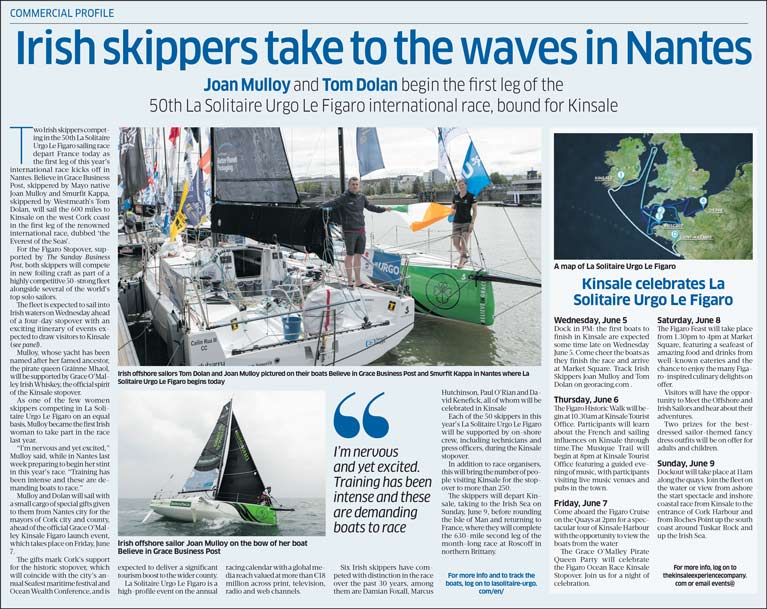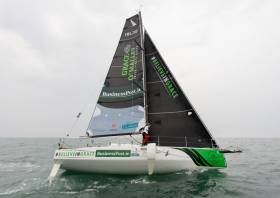Displaying items by tag: La Solitaire URGO Le Figaro
Irish Skippers Take To The Waves In Nantes Today Bound For Kinsale In 50th Figaro Race
Today’s Sunday Business Post will carry a special preview of the first leg of the 50th La Solitaire URGO Le Figaro international race as the skippers set sail from Nantes for Kinsale.
The West Cork stopover this coming week is supported by the newspaper, which is also a title sponsor of second-time Figaro contender Joan Mulloy’s Believe in Grace/BusinessPost.ie.
The Mayo native will be sailing the 600 miles to Kinsale alongside fellow Irish skipper Tom Dolan, on Smurfit Kappa, in the first leg of the renowned offshore solo race that’s been dubbed ‘The Everest of the Seas’.
 The Sunday Business Post features the race, the Irish skippers competing and the Kinsale stopover
The Sunday Business Post features the race, the Irish skippers competing and the Kinsale stopover
Both are competing in new Beneteau Figaro 3 foiling craft as part of a highly competitive 47-strong fleet alongside several of the world’s top solo sailors.
The fleet is expected to sail into Irish waters on Wednesday 5 June ahead of a four-day stopover with an exciting itinerary of events (see below) expected to draw visitors to Kinsale ahead of next weekend’s SeaFest in nearby Cork Harbour.
Mulloy, whose yacht has been named after her famed ancestor ‘The Pirate Queen’ Gráinne Mhaol, will be supported by Grace O’Malley Irish Whiskey, the official spirit of the Kinsale stopover.
As one of the few women skippers competing in La Solitaire Urgo Le Figaro on an equal basis, Mulloy became the first Irish woman to take part in the race last year
“I’m nervous and yet excited,” Mulloy said, while in Nantes last week preparing to begin her stint in this year’s race. “Training has been intense and these are demanding boats to race.”
Mulloy and Dolan will sail with a small cargo of special gifts given to them From Nantes for the mayors of Cork City and County ahead of the official Grace O’Malley Kinsale Figaro launch event on Friday 7 June.
The gifts mark Cork’s support for the historic stopover, which will coincide with the city’s annual Seafest maritime festival and Ocean Wealth Conference, and is expected to deliver a significant tourism boost to the wider county.
La Solitaire URGO Le Figaro is a high-profile event on the annual racing calendar with a global media reach valued at more than €18 million across print, television, radio and web channels.
Six Irish skippers have competed with distinction in the race over the past 30 years, among them Damian Foxall, Marcus Hutchinson, Paul O’Rian and David Kenefick — all of whom will be celebrated in Kinsale.
Each of the 50 skippers in this year’s La Solitaire URGO Le Figaro will be supported by on-shore crew, including technicians and press officers, during the Kinsale stopover.
In addition to race organisers, this will bring the number of people visiting Kinsale for the stopover to more than 250.
The skippers will depart Kinsale next Sunday 9 June and cross for the Irish Sea before rounding the Isle of Man and returning to France, where they will complete the 630-mile second leg of the month-long race at Roscoff in northern Brittany.
For more info and to track the boats, visit the official website for La Solitaire URGO Le Figaro HERE.
Programme of events for Kinsale Stopover
Wednesday 5 June
- Dock in PM: The first boats to finish in Kinsale are expected sometime late on Wednesday June 5. Come cheer the boats as they finish the race and arrive at Market Square. Track Irish Skippers Joan Mulloy and Tom Dolan on georacing.com.
Thursday 6 June
- The Figaro Historic Walk will begin at 10.30am at Kinsale Tourist Office. Participants will learn about the French and sailing influences on Kinsale through time.
- The Musique Trail will begin at 8pm at Kinsale Tourist Office featuring a guided evening of music with participants visiting live music venues and pubs in the town.
Friday 7 June
- Come aboard the Figaro Cruise on The Quays at 2pm for a spectacular tour of Kinsale Harbour with the opportunity to view the boats from the water.
- The Grace O’ Malley Pirate Queen Party will celebrate the Figaro Ocean Race Kinsale Stopover. Join us for a night of celebration.
Saturday 8 June
- The Figaro Feast will take place from 1.30pm to 4pm at Market Square, featuring a sea-feast of amazing food and drinks from well-known eateries and the chance to enjoy the many Figaro-inspired culinary delights on offer.
- Visitors will have the opportunity to meet the offshore and Irish sailors and hear about their adventures.
- Two prizes for the best-dressed sailor-themed fancy dress outfits will be on offer for adults and children.
Sunday 9 June
- Dockout will take place at 11am along the quays. Join the fleet on the water or view from ashore the start spectacle and inshore coastal race from Kinsale to the entrance of Cork Harbour and from Roches Point up the south coast around Tuskar Rock and up the Irish Sea.
For more info, visit TheKinsaleExperienceCompany.com or email [email protected].





























































